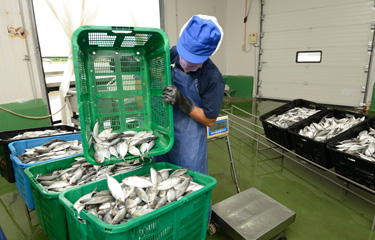Thanks to decades of increased fishery and aquaculture yields and growing global demand, seafood is one of the most-traded food categories in the world today. However, the volume and value of overseas sales achieved by the industry has slipped in the past few years, according to the latest analysis from the Food and Agriculture Organization of the United Nations (FAO).
The 2022 edition of the U.N. body’s biennial “The State of World Fisheries and Aquaculture” (SOFIA) report confirms 59.8 million metric tons (MT) of seafood products worth USD 151 billion (EUR 148.4 million) were exported in 2020, the most-recent year for which data is available. This value was down from the record high USD 165 billion (EUR 162.2 billion) that the FAO recorded for 2018, while the live-weight equivalent volume was around 200,000 metric tons (MT) lower.
Nevertheless, the nominal value of aquatic product exports in 2020 was nearly 20 times higher than in 1976 – in line with the value growth of global merchandise trade during the period, which increased at a rate of 6.8 percent per year in nominal terms between 1976 and 2020, and by 3.7 percent in real terms. Seafood exports increased at an average rate of 2.9 percent per year live-weight equivalent).
The faster rate of growth in the value of trade of aquatic products reveals that a higher proportion of seafood trading volumes are comprised of high-value species and products undergoing processing or other forms of value-addition. Other contributors to the shift in value include inflation and growth in demand, leading to price increases in the long term.
The European Union was the largest single market for seafood in 2020, accounting for 34 percent of the global value of imports, while the United States was the largest importing country, accounting for 15 percent of the world’s seafood imports by value, followed by China (10 percent), Japan (9 percent), Spain (5 percent), and France (4 percent).
However, in terms of volume (live weight), China is the top importing country of aquatic products, far ahead of the U.S.. China imports large quantities of species not only for domestic consumption but also as raw materials to be processed in China and then re-exported, according to SOFIA.
China is the world’s largest producer, exporter, and processor of aquatic products, with its exports comprising large quantities of domestically produced cephalopods, shrimp, tilapia and bivalve mollusks, alongside processed whitefish such as Alaska pollock and cod. In 2020, China exported USD 18 billion (EUR 17.7 billion) worth of seafood products, accounting for 12 percent of the global total. Although its market share has declined slightly from its 2015 peak, it remains well above historical levels – China accounted for only 1.6 percent of the global exports of aquatic products in value in 1976.
The top export destinations for Chinese seafood products in 2020 were Japan, the United States, and the Republic of Korea, accounting for 18 percent, 11 percent, and 9 percent of China’s total export value, respectively.
Norway, meanwhile, has been the second-largest exporter of seafood since 2004. In 2020, the Scandinavian country sold USD 11 billion (EUR 10.8 billion) worth of products, accounting for 7.4 percent of the global total.
In addition to being the world’s largest producer of farmed Atlantic salmon, Norway also records significant catches and exports of small pelagics, and groundfish species such as cod. The E.U. is by far Norway’s most-important market, accounting for 60 percent of its total export value.
In third place is Vietnam, which thanks to its status as the world’s leading producer and exporter of farmed pangasius, as well as its large farmed shrimp industry and significant processing sector, exported some USD 8.5 billion (EUR 8.4 billion) worth of products in 2020, accounting for 5.6 percent of the global total.
In terms of species, salmonids have been the top seafood commodity traded in value since 2013, accounting for about 18 percent of the total value of seafood traded in 2020. The other main groups of exported species that year were shrimp and prawns with about 16 percent of the total, followed by tuna, bonito, and billfish (9.7 percent); cod, hakes and haddock (9.6 percent); and squids, cuttlefish and octopus (6.8 percent).
Led by Norway and Chile, 2020’s global salmon exports reached a value of USD 27.6 billion (EUR 27.1 billion), while the trade of shrimp and tuna totaled USD 24.7 billion (EUR 24.3 billion) and USD 14.6 billion (EUR 14.4 billion), respectively.
Looking ahead, and with SOFIA 2022 forecasting that worldwide seafood production will increase by 14 percent to reach 202 million MT by 2030, the FAO projects that about 36 percent of the total fisheries and aquaculture yields that year will be exported (31 percent if trade within the E.U. is not included). It also expects that China will continue to be the world’s top seafood exporter, followed by Vietnam and Norway.
The bulk of the world’s growth in exports will originate from Asia, which will account for about 52 percent of the additional exported volumes by 2030. As such, Asia’s share in total trade of aquatic products for human consumption will increase from 47 percent in 2020 to 48 percent in 2030.
High-income countries will remain highly dependent on imports to meet domestic demand, according to the report, with the E.U., Japan, and the U.S. accounting for 39 percent of total imports for aquatic food consumption in 2030, a slightly lower share than in 2020 (40 percent).
Photo courtesy of Jordan Lye/Shutterstock







